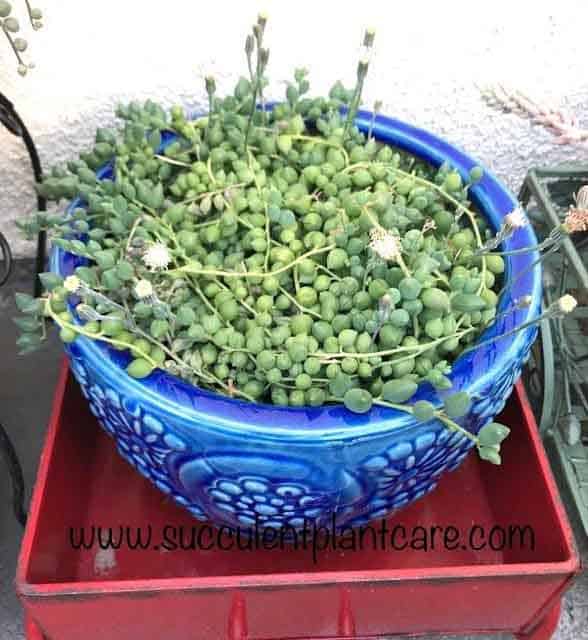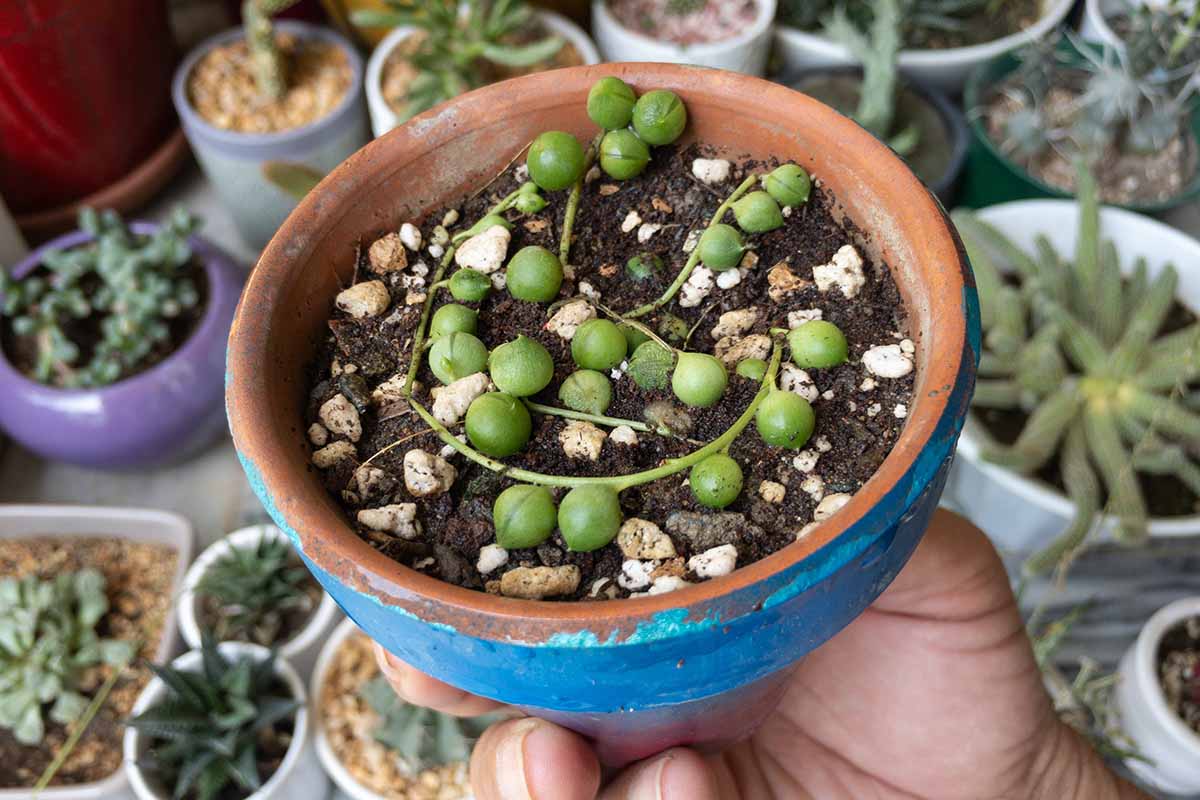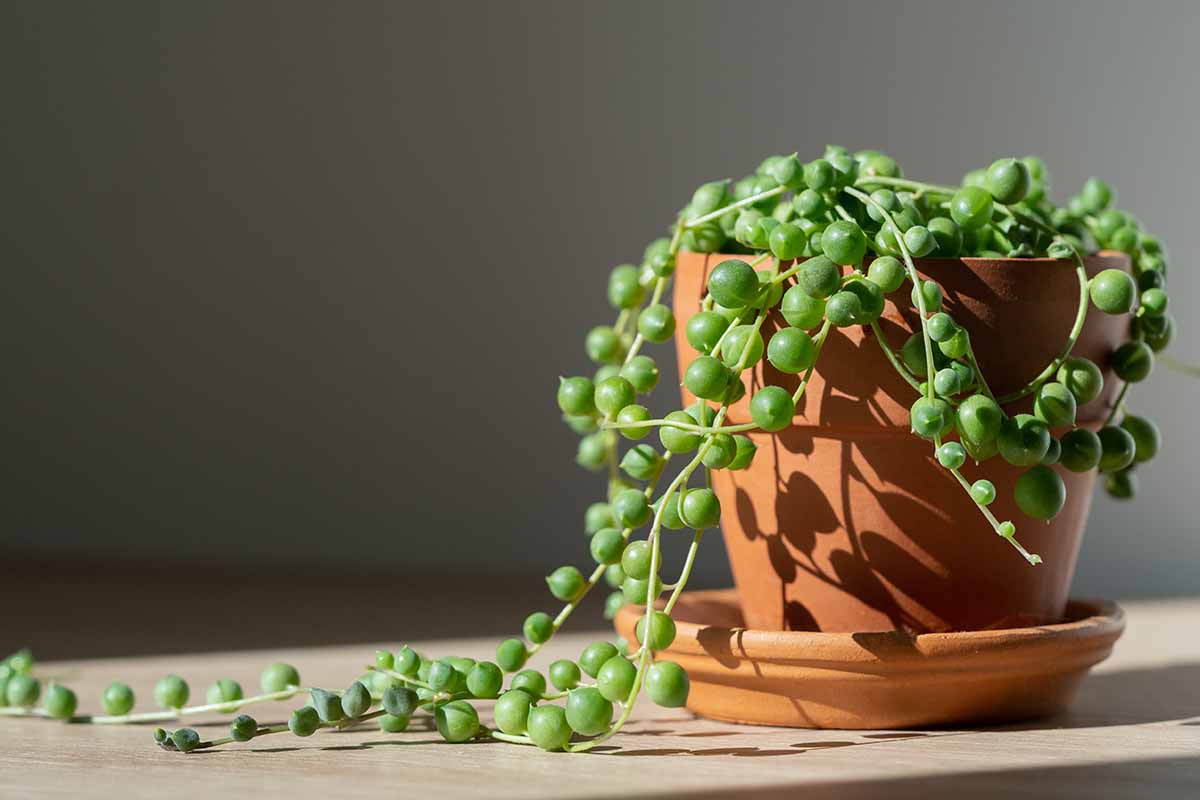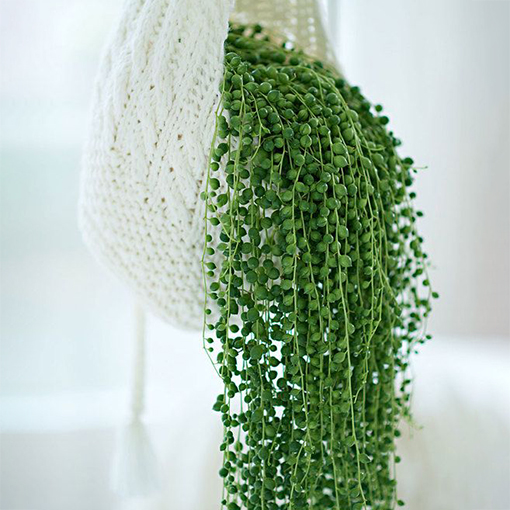The Unique Needs of Senecio rowleyanus
The String of Pearls plant, scientifically known as Senecio rowleyanus, is a popular choice for indoor gardening due to its unique and attractive appearance. This succulent plant is native to South Africa and has adapted to thrive in dry, rocky areas with limited water availability. To care for a String of Pearls plant effectively, it’s essential to understand its specific needs and provide the right conditions for optimal growth.
One of the primary reasons String of Pearls plants are favored by indoor gardeners is their ability to tolerate neglect. However, this doesn’t mean they can thrive in any environment. To keep your String of Pearls plant happy and healthy, you’ll need to provide it with the right balance of light, water, temperature, and humidity. In this article, we’ll delve into the specifics of how to care for a String of Pearls plant, covering topics such as lighting, watering, fertilization, and propagation.
By understanding the unique needs of your String of Pearls plant, you’ll be able to create an environment that fosters healthy growth and encourages your plant to thrive. Whether you’re a seasoned indoor gardener or just starting out, learning how to care for a String of Pearls plant is a rewarding experience that will bring joy and beauty to your home.
So, how do you care for a String of Pearls plant? It all starts with understanding the plant’s natural habitat and replicating those conditions in your home. By providing the right environment and following a few simple care tips, you’ll be able to enjoy the beauty of your String of Pearls plant for years to come.
Lighting Conditions for Optimal Growth
When it comes to providing the right lighting conditions for your String of Pearls plant, it’s essential to understand the difference between direct and indirect sunlight. Direct sunlight can be too intense for this succulent plant, causing the leaves to become scorched and the stems to become leggy. On the other hand, indirect sunlight provides the perfect amount of light for photosynthesis, promoting healthy growth and development.
To determine the right amount of light for your String of Pearls plant, consider the following factors: the time of day, the season, and the location of the plant. East- or west-facing windows are ideal for String of Pearls plants, as they provide gentle, indirect sunlight. Avoid placing your plant in a south-facing window, as the direct sunlight can be too intense.
If you’re unsure about the lighting conditions in your home, you can use a light meter to measure the intensity of the light. Most String of Pearls plants prefer bright, indirect light with an intensity of around 10,000-20,000 lux. You can also observe your plant’s behavior and adjust the lighting conditions accordingly. If the leaves are becoming scorched or the stems are becoming leggy, it may be a sign that the plant is receiving too much direct sunlight.
By providing the right lighting conditions, you’ll be able to promote healthy growth and development in your String of Pearls plant. Remember, the key is to find a balance between providing enough light for photosynthesis and avoiding direct sunlight that can cause damage. With the right lighting conditions, your String of Pearls plant will thrive and become a beautiful addition to your home.
Learning how to care for a String of Pearls plant requires attention to detail and a willingness to adapt to the plant’s specific needs. By understanding the importance of lighting conditions and making adjustments accordingly, you’ll be able to create an environment that fosters healthy growth and encourages your plant to thrive.
Watering Wisdom: Avoiding Overhydration and Underhydration
Watering is one of the most critical aspects of caring for a String of Pearls plant. Overhydration and underwatering can both be detrimental to the plant’s health, so it’s essential to find the right balance. To determine when to water your String of Pearls plant, check the soil moisture by sticking your finger into the soil up to the first knuckle. If the soil feels dry, it’s time to water.
When watering your String of Pearls plant, make sure to water thoroughly, allowing excess water to drain from the pot. This will help prevent waterlogged soil and root rot. It’s also essential to avoid getting water on the leaves or crown of the plant, as this can cause rot and other problems.
A general rule of thumb for watering String of Pearls plants is to water every 7-10 days during the spring and summer months when the plant is actively growing. During the fall and winter months, reduce watering to every 4-6 weeks, as the plant is dormant. However, this is just a general guideline, and the specific watering needs of your plant may vary depending on the climate, humidity, and light levels in your home.
It’s also important to consider the potting mix when watering your String of Pearls plant. A well-draining potting mix can help prevent waterlogged soil and root rot. Look for a potting mix that contains ingredients like perlite, vermiculite, or sand, which will help improve drainage and prevent water from accumulating in the soil.
By understanding the watering needs of your String of Pearls plant and taking steps to avoid overhydration and underwatering, you’ll be able to create a healthy and thriving environment for your plant. Remember, the key is to find a balance between providing enough water for the plant’s needs and avoiding excessive watering that can cause problems.
Learning how to care for a String of Pearls plant requires attention to detail and a willingness to adapt to the plant’s specific needs. By mastering the art of watering, you’ll be able to provide your plant with the right conditions for optimal growth and development.
Temperature and Humidity: Creating a Comfortable Environment
String of Pearls plants prefer a comfortable temperature range between 65°F (18°C) and 75°F (24°C) during the day and no lower than 55°F (13°C) at night. Avoid placing your plant near heating or cooling vents, fireplaces, or drafty windows, as this can cause temperature fluctuations that can stress the plant.
In terms of humidity, String of Pearls plants prefer a relatively low humidity environment, around 40-50%. This is because they are adapted to the dry conditions of their native South Africa. To maintain the right humidity level, you can use a humidifier or group plants together to create a microclimate.
It’s also important to consider the temperature and humidity changes that occur during different seasons. During the spring and summer months, the temperature and humidity levels tend to be higher, while during the fall and winter months, they tend to be lower. To adapt to these changes, you can adjust the placement of your plant or use a thermometer and hygrometer to monitor the temperature and humidity levels.
By maintaining a stable temperature and humidity environment, you’ll be able to create a comfortable space for your String of Pearls plant to thrive. Remember, the key is to find a balance between providing the right conditions for growth and avoiding extreme temperatures and humidity levels that can cause stress.
Learning how to care for a String of Pearls plant requires attention to detail and a willingness to adapt to the plant’s specific needs. By understanding the importance of temperature and humidity, you’ll be able to provide your plant with the right conditions for optimal growth and development.
When it comes to creating a comfortable environment for your String of Pearls plant, it’s also important to consider the potting mix and container. A well-draining potting mix can help prevent waterlogged soil and root rot, while a container with good air circulation can help maintain a healthy temperature and humidity level.
Fertilization and Pruning: Encouraging Healthy Growth
Fertilization is an essential part of caring for a String of Pearls plant. During the growing season, which typically runs from spring to fall, feed your plant with a balanced, water-soluble fertilizer. Dilute the fertilizer to half the recommended strength to avoid burning the roots.
When it comes to choosing a fertilizer, look for one that is high in phosphorus, as this will promote healthy root growth and development. You can also use a fertilizer that is specifically formulated for cacti and succulents, as these plants have similar nutritional needs.
Pruning is another important aspect of caring for a String of Pearls plant. Prune your plant regularly to maintain its shape and encourage healthy growth. Remove any dead or damaged stems, and cut back long stems to encourage branching.
Pruning also helps to prevent legginess, which can occur when the plant is not receiving enough light. By pruning your plant regularly, you can encourage it to grow more compactly and prevent it from becoming leggy.
When pruning your String of Pearls plant, use a pair of clean, sharp scissors or pruning shears. Make clean cuts just above a node, and remove any weak or spindly growth. This will help to promote healthy growth and prevent the spread of disease.
By fertilizing and pruning your String of Pearls plant regularly, you can encourage healthy growth and development. Remember to always use a balanced fertilizer and prune your plant regularly to maintain its shape and prevent legginess.
Learning how to care for a String of Pearls plant requires attention to detail and a willingness to adapt to the plant’s specific needs. By understanding the importance of fertilization and pruning, you’ll be able to provide your plant with the right conditions for optimal growth and development.
Pest Control and Common Problems: Troubleshooting Tips
String of Pearls plants are generally hardy and resistant to pests, but they can still be susceptible to certain problems. Mealybugs, spider mites, and root rot are some of the most common issues that can affect these plants.
Mealybugs are small, white, cottony insects that can infest the stems and leaves of your String of Pearls plant. To control mealybugs, use a gentle insecticidal soap or neem oil, and make sure to isolate the plant to prevent the infestation from spreading.
Spider mites are tiny, spider-like insects that can cause yellowing or bronzing of the leaves. To control spider mites, use a fine spray of water to wash them off the plant, and then treat the plant with a miticide.
Root rot is a common problem that can occur when the soil is too moist or waterlogged. To prevent root rot, make sure to use a well-draining potting mix and avoid overwatering your plant.
Other common problems that can affect String of Pearls plants include leaf drop, stem rot, and fungal infections. To troubleshoot these issues, inspect your plant carefully and adjust its care accordingly. For example, if the leaves are dropping, it may be a sign that the plant is not receiving enough light or water.
By being aware of these common problems and taking steps to prevent them, you can help keep your String of Pearls plant healthy and thriving. Remember to always inspect your plant regularly and take action quickly if you notice any signs of pests or disease.
Learning how to care for a String of Pearls plant requires attention to detail and a willingness to adapt to the plant’s specific needs. By understanding the common problems that can affect these plants, you’ll be able to provide your plant with the right conditions for optimal growth and development.
Propagation and Repotting: Sharing and Refreshing Your Plant
Propagation is a great way to share your String of Pearls plant with friends and family, or to refresh your plant’s appearance. There are two main methods of propagation: stem cuttings and division.
To propagate through stem cuttings, cut a healthy stem section from the mother plant, making sure each section has at least two nodes. Remove lower leaves, dip the cut end in rooting hormone, and plant the cutting in a well-draining potting mix. Keep the soil moist and warm until roots develop.
Division is another method of propagation, which involves separating the roots of a mature plant. Carefully remove the plant from its pot, and gently separate the roots. Replant the separated sections in a well-draining potting mix, and keep the soil moist and warm until the new plants establish themselves.
Repotting is also an essential part of caring for a String of Pearls plant. As the plant grows, it may outgrow its container, and repotting provides an opportunity to refresh the soil and provide a larger pot if necessary. Choose a pot that is only slightly larger than the previous one, and use a well-draining potting mix to prevent waterlogged soil.
When to repot your String of Pearls plant depends on its growth rate and the time of year. Spring and summer are the best times to repot, as the plant is actively growing. Avoid repotting during the fall and winter months, as the plant is dormant.
By propagating and repotting your String of Pearls plant, you can share it with others, refresh its appearance, and provide it with the best conditions for growth and development. Remember to always use a well-draining potting mix and provide the right amount of light and water for your plant.
Learning how to care for a String of Pearls plant requires attention to detail and a willingness to adapt to the plant’s specific needs. By understanding the art of propagation and repotting, you’ll be able to provide your plant with the right conditions for optimal growth and development.
Displaying Your String of Pearls: Creative Ideas and Inspiration
Once you’ve mastered the art of caring for your String of Pearls plant, it’s time to think about how to display it. This unique and beautiful plant can add a touch of elegance and sophistication to any room, and there are many creative ways to showcase it.
One popular way to display a String of Pearls plant is in a hanging basket. This allows the plant’s trailing stems to cascade down, creating a stunning display of greenery. Choose a basket that complements the plant’s natural beauty, such as a wicker or macrame basket.
Another creative way to display your String of Pearls plant is in a terrarium. This is a great option if you want to create a miniature indoor garden, and it can be a beautiful and self-sustaining ecosystem. Choose a glass container that is large enough to accommodate the plant’s growth, and add some decorative rocks or pebbles to create a visually appealing display.
Decorative pots are also a great way to showcase your String of Pearls plant. Choose a pot that complements the plant’s natural beauty, such as a ceramic or clay pot. You can also add some decorative elements, such as shells or pebbles, to create a visually appealing display.
In addition to these ideas, you can also get creative with how you display your String of Pearls plant. For example, you could use a trellis or a obelisk to support the plant’s stems, or you could create a living wall using a series of small pots or planters.
By displaying your String of Pearls plant in a creative and visually appealing way, you can add a touch of elegance and sophistication to any room. Remember to choose a display method that complements the plant’s natural beauty, and don’t be afraid to get creative and experiment with different ideas.
Learning how to care for a String of Pearls plant requires attention to detail and a willingness to adapt to the plant’s specific needs. By understanding the importance of proper care and display, you’ll be able to provide your plant with the right conditions for optimal growth and development.








